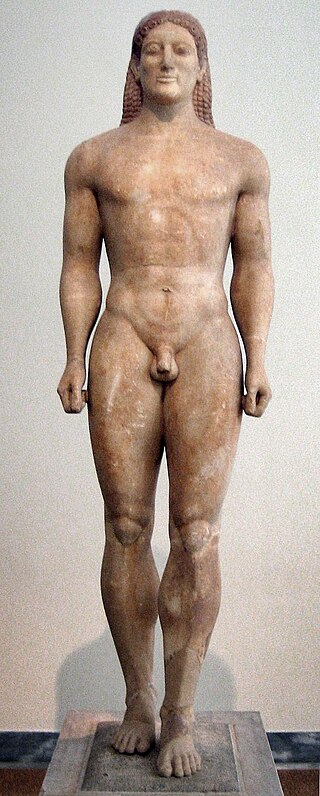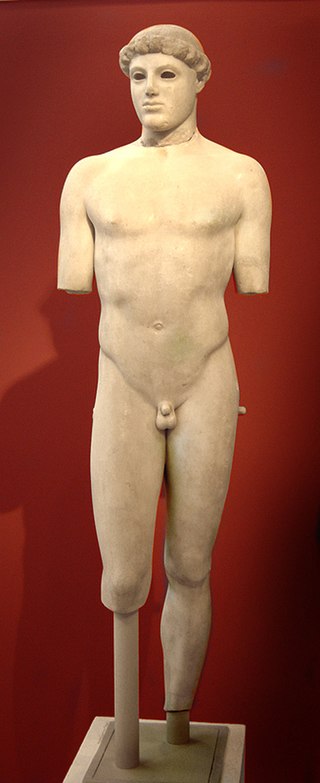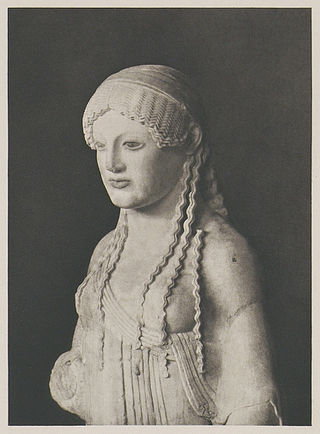
Kouros is the modern term given to free-standing Ancient Greek sculptures that depict nude male youths. They first appear in the Archaic period in Greece and are prominent in Attica and Boeotia, with a less frequent presence in many other Ancient Greek territories such as Sicily. Such statues are found across the Greek-speaking world; the preponderance of these were found in sanctuaries of Apollo with more than one hundred from the sanctuary of Apollo Ptoion, Boeotia, alone. These free-standing sculptures were typically marble, but the form is also rendered in limestone, wood, bronze, ivory and terracotta. They are typically life-sized, though early colossal examples are up to 3 meters tall.

The sculpture of ancient Greece is the main surviving type of fine ancient Greek art as, with the exception of painted ancient Greek pottery, almost no ancient Greek painting survives. Modern scholarship identifies three major stages in monumental sculpture in bronze and stone: the Archaic, Classical (480–323) and Hellenistic. At all periods there were great numbers of Greek terracotta figurines and small sculptures in metal and other materials.

The archaic smile was used by sculptors in Archaic Greece, especially in the second quarter of the 6th century BCE, possibly to suggest that their subject was alive and infused with a sense of well-being. One of the most famous examples of the archaic smile is the Kroisos Kouros, and the Peplos Kore is another.

The marble Kritios Boy or Kritian Boy belongs to the Early Classical period of ancient Greek sculpture. It is the first statue from classical antiquity known to use contrapposto; Kenneth Clark called it "the first beautiful nude in art" The Kritios Boy is thus named because it is attributed, on slender evidence, to Kritios, who worked together with Nesiotes or their school, from around 480 BC. As currently mounted, the statue is considerably smaller than life-size at 117 cm, including the supports that replace the missing feet.

The Severe style, or Early Classical style, was the dominant idiom of Greek sculpture in the period ca. 490 to 450 BCE. It marks the breakdown of the canonical forms of archaic art and the transition to the greatly expanded vocabulary and expression of the classical moment of the late 5th century. It was an international style found at many cities in the Hellenic world and in a variety of media including: bronze sculpture in the round, stelae, and architectural relief. The style perhaps realized its greatest fulfillment in the metopes of the Temple of Zeus, Olympia.

Moschophoros is an ancient Greek statue of the Archaic period, also known in English as The Calf Bearer. It was excavated in fragments in the Perserschutt on the Acropolis of Athens in 1864. The statue, dated c. 560 BC and estimated to have originally measured 1.65 meters (5.4 ft) in height, is now in the Acropolis Museum in Athens, Greece.

The Getty kouros is an over-life-sized statue in the form of a late archaic Greek kouros. The dolomitic marble sculpture was bought by the J. Paul Getty Museum, Los Angeles, California, in 1985 for ten million dollars and first exhibited there in October 1986.

The Rampin Rider or Rampin Horseman is an equestrian statue from the Archaic Period of Ancient Greece. The statue was made of marble and has traces of red and black paint.

Gods in Color or Gods in Colour (original title in German: Bunte Götter – Die Farbigkeit antiker Skulptur is a travelling exhibition of varying format and extent that has been shown in multiple cities worldwide. Its subject is ancient polychromy, i.e. the original, brightly painted, appearance of ancient sculpture and architecture.
The Sounion Kouros is an early archaic Greek statue of a naked young man or kouros carved in marble from the island of Naxos around 600 BCE. It is one of the earliest examples that scholars have of the kouros-type which functioned as votive offerings to gods or demi-gods, and were dedicated to heroes. Found near the Temple of Poseidon at Cape Sounion, this kouros was found badly damaged and heavily weathered. It was restored to its original height of 3.05 meters (10.0 ft) returning it to its larger than life size. It is now held by the National Archaeological Museum of Athens.
The Phrasikleia Kore is an Archaic Greek funerary statue by the artist Aristion of Paros, created between 550 and 540 BCE. It was found carefully buried in the ancient city of Myrrhinous in Attica and excavated in 1972. The exceptional preservation of the statue and the intact nature of the polychromy elements makes the Phrasikleia Kore one of the most important works of Archaic art.
The Peplos Kore is an ancient sculpture from the Acropolis of Athens. It is considered one of the best-known examples of Archaic Greek art. Kore is a type of archaic Greek statue that portrays a young woman with a stiff posture looking straight forward. Although this statue is one of the most famous examples of a kore, it is actually not considered a typical one. The statue is not completely straight, her face is leaned slightly to the side, and she is standing with her weight shifted to one leg. The other part of the statue's name, peplos, is based on the popular archaic Greek gown for women. When the statue was found it was initially thought that she was wearing a peplos, although it is now known that she is not.

The Antenor Kore is a Late Archaic statue of a girl (Kore) made of Parian marble, which was created around 530/20 BC.

The Korai of the Acropolis of Athens are a group of female statues (Korai), discovered in the Perserschutt of the Acropolis of Athens in the last quarter of the nineteenth century, all of the same typology and clear votive function. Through them it is possible to trace the stylistic evolution of Archaic Attic sculpture for almost a century, from 570 to 480 BC. This demonstrates in particular the beginning and development of Ionian influence on Athenian art of the second half of the 6th century BC. This was the period when Ionian elements first appear in the architectural works of the Peisistratids and close connections between Ionia and Athens developed. Towards the end of the 6th century BC this influence is seen to be overcome, or rather absorbed, and a new style is born, the so-called Severe style, with increasing Peloponnesian influence.

Vinzenz Brinkmann is a German classical archaeologist.

The Kouros of Apollonas, also called the Colossus of Dionysus, is a 10.7 metre tall unfinished statue of light grey Naxian marble with a weight of around 80 tonnes. It is located in an ancient quarry near Apollonas, a small town in the northern part of Naxos, one of the Cycladic Islands in the Aegean Sea. The statue is a kouros dating from Archaic period of Ancient Greece, around the turn of the seventh and sixth centuries BC.
Ernst Langlotz was a German classical archaeologist and art historian, who specialized in Greek sculpture of the 6th and 5th centuries BCE.

The pediments of the Parthenon are the two sets of statues in Pentelic marble originally located as the pedimental sculpture on the east and west facades of the Parthenon on the Acropolis of Athens. They were probably made by several artists, including Agoracritos. The master builder was probably Phidias. They were probably lifted into place by 432 BC, having been carved on the ground.

The Euthydikos Kore is a late archaic, Parian marble statue of the kore type, c 490–480 BCE, that once stood amongst the Akropolis votive sculptures. It was destroyed during the Persian invasion of 480 BCE and found in the Perserschutt. It is named after the dedication on the base of the sculpture, “Euthydikos son of Thaliarchos dedicated [me]”. It now stands in the Acropolis Museum.

The Persian Rider is an archaic Greek equestrian sculpture, c. 520–500 BCE, that once stood on the Acropolis of Athens. Only fragmentary remains survive; the lower torso and legs of the rider and the head, forelegs and chest of the horse. It was found west of the Erechtheion in 1886 and reconstructed by Franz Studniczka. Significant amounts of the original surface painting remains on the statue including the multicoloured pattern on the leggings of the rider which is thought to indicate that he was Persian or Scythian, hence the name. The sculpture now stands in the Acropolis Museum.




















